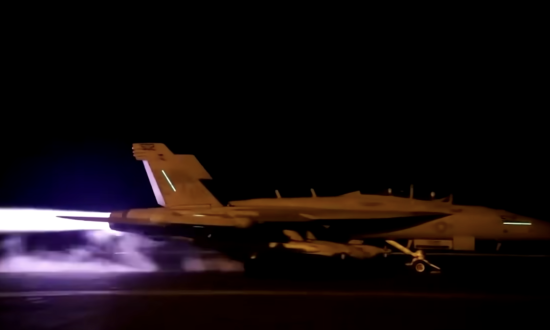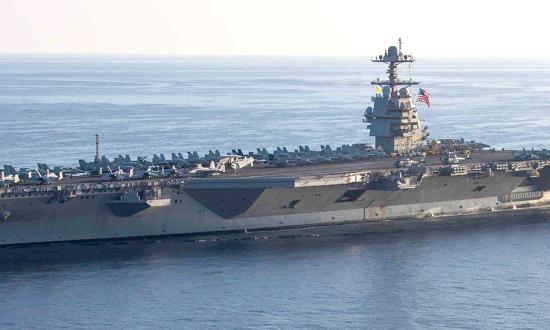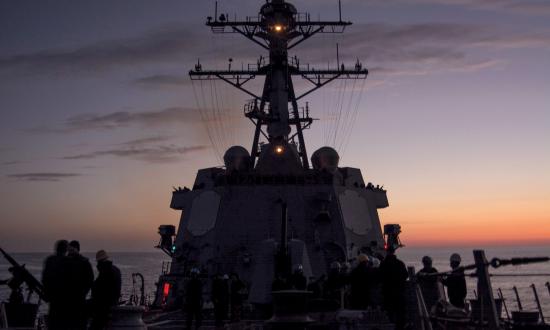The world wonders: What is the endgame in the low-grade maritime war in the Red Sea, and when will we get there? My answer: Don’t hold your breath. Yemen’s Houthi rebels don’t need to mount much of a threat to shipping to achieve their goals, while the U.S.-led naval coalition needs to completely defeat the Houthi threat to prevail. Coalition leaders likely will balk at what needs to be done. And if they don’t, land warfare in Yemen lies in store. Seldom does ground combat in the Middle East end swiftly or neatly. Regardless, the auguries point to protracted, indeterminate fighting between shore and sea.
Disruption in the Red Sea
Since 19 November, the Houthis have pelted commercial shipping passing through this critical waterway for trade and commerce, conducting 30 antiship missile or drone attacks and scoring 14 hits. As insurance rates skyrocketed, major shipping firms such as Maersk began rerouting merchantmen around the Red Sea, directing them to take the longer and more arduous but also safer route around the Cape of Good Hope into the South Atlantic. Shipping-firm executives profess little faith in navies’ ability to restore order to regional waters.
In a bid to restore maritime security, Washington has assembled a coalition dubbed Prosperity Guardian to police the sea. To date, U.S. destroyers have brought down 21 missiles and 50 drones bound for merchant traffic. After U.S. leaders ordered missile and air strikes against shore positions in Yemen, Houthi rocketeers took U.S. Navy and coalition warships under fire as well. A missile closed to within a mile of the destroyer USS Gravely (DDG-107) last week before being swatted down by the Gravely’s close-in weapon system.
Martial Logic
What does the future hold? Let us peer through a glass darkly, discerning the nature of this limited but consequential sea war. Carl von Clausewitz, who knew a thing or two about affairs of arms, explains that “the first, the supreme, the most far-reaching act of judgment that the statesman and commander have to make is to establish by that test the kind of war on which they are embarking; neither mistaking it for, nor trying to turn it into, something that is alien to its nature. This is the first of all strategic questions and the most comprehensive.”
Four facets of this strange conflict stand out. One, it pits a land-based, substate armed group wielding military-grade hardware against oceangoing state combatants deploying conventional naval forces. The coalition confronts yet another irregular war blurring the lines between unconventional and conventional methods of war making.
Two, both the Houthis and the guardians of the sea lanes are waging “limited” war against each another. “Unlimited” war connotes forcibly unseating a hostile government and imposing your will on the vanquished. Yemeni rebels have neither the means nor the need to topple the U.S. government to make a statement about solidarity with the Palestinian cause. They merely need to make mischief for Israel and the seafaring societies that have supported Israeli operations in Gaza. Doing so inflicts economic pain and exacts a price for standing with Israel, meeting Houthi goals.
For their part, U.S. leaders have said nothing about eradicating the Houthis as a fighting force. They merely want to halt attacks on shipping so normal trading patterns can resume. They too entertain a limited aim; namely, restoring the status quo of tranquil sea lanes. The problem for Washington is that there may be no way to stop Houthi attacks short of destroying the armed group. To succeed may mean embracing unlimited aims, requiring military escalation. Remaining constrained courts failure.
Three, there is a mismatch between how much the combatants prize their goals and how much they are prepared to spend to attain them. As Clausewitz observes, the value a contender places on its “political object”—the goal it sets for a warlike undertaking—determines the “magnitude” and “duration” of the effort it puts forth to obtain that object. The magnitude is the rate at which a belligerent expends militarily relevant resources on its goal; duration is how long it keeps up the expenditure. Rate x time = the cost of the political goal.
If the belligerent’s political leaders, society, and armed forces want the goal enough to pay the requisite price, they proceed with the endeavor. If not, they forgo it.
Clausewitzian martial logic resembles consumer logic. When you go to buy an automobile on the installment plan, you determine the amount of each monthly payment and the number of payments it will take to pay off the loan. Multiplying the two numbers reveals the total price of your new car. If you care enough about that particular car to pay the price, you sign the contract. If not, you look for a humbler ride that fits your needs and wants.
The same holds in martial encounters: If you covet something ardently, you’re prepared to spend lavishly on it for a long time. If you harbor only middling desire for the goal, you invest middling resources in it for a finite period. And if the cost spirals out of control after you launch into the venture, you write off the goal and quit the venture on the best terms possible.
Now, consider the Red Sea. Religion is an accelerant for Houthi political and strategic calculations. It primes militant leaders to place enormous weight on their political object. In other words, how much the Houthis crave their goals in the Red Sea governs the rate at which they are prepared to expend military resources to make trouble for Israel and the West and how long they are prepared to keep doing so.
It’s of surpassing importance to Houthi magnates to make their statement about Gaza. So, they are prepared to spend to the utmost—out of a meager stock of military resources, granted—for as long as it takes for that statement to resound. That portends a prolonged campaign against shipping.
The same logic goes for Western defenders of nautical freedom, yet it’s far from clear that U.S. leaders treasure their aims in the Red Sea as much as Houthis do theirs. Prosperity is at risk in marginal seas all around the Eurasian periphery, including not just the Red Sea but also the Black Sea, eastern Mediterranean, Arabian Sea, and South China Sea. Freedom of navigation—freedom of movement for ships to proceed from point A to point B on the nautical chart—is in jeopardy. Houthi attacks are a pocketbook issue for the electorate, and votes concentrate minds—especially in an election year. “No shipping, no shopping,” as one maritime consultant recently told Congress.
Freedom of the Sea
The problem is about more than freedom of movement. Freedom of the sea is likewise in peril. Freedom of the sea refers to seafaring states’ liberty to do as they wish in the maritime commons with exceptions codified by treaty. It encompasses the freedom to conduct reconnaissance flights, underwater surveys, and kindred military activities. Yet, the United States has proven a tepid defender of freedom of the sea in expanses such as the South China Sea, where China unlawfully asserts “indisputable sovereignty”—in effect state ownership—of an economically critical sea route.
If successive presidential administrations have done little to uphold freedom of the sea in East Asia, a region of paramount importance to the Pentagon, it seems doubtful they would display more resolve in the Red Sea, a theater of secondary importance. If not, the United States’ commitment could prove wobbly despite its infinitely superior resource base vis-à-vis the Houthis. The rebels could prevail despite being outmatched by all conceivable material measures.
Four, both the Houthis and the guardians of commercial shipping are waging what Admiral J. C. Wylie would call “cumulative” campaigns. Such campaigns are indecisive in themselves, but that does not matter much for the Houthis. It matters a great deal for the United States and its partners because they need decisive results to prevail. Wylie observes that “sequential” operations constitute the norm in military history: A campaign proceeds from one tactical action to the next to the next until the campaign reaches its goal. Each action depends on the preceding one and shapes the subsequent one. He opines that only sequential operations can yield a decisive outcome, giving the combatant prosecuting them control of whatever its leaders want to control. For Wylie, control is the point of military strategy, whether it is control of geographic space, the enemy fighting force, or something else.
By contrast, cumulative operations are scattershot. They are made up of individual tactical actions that don’t follow one another in sequence, either on the map or in time. The contestant pursuing a cumulative strategy attempts to grind down its antagonist by inflicting low-grade damage at many places rather than meting out a series of punishing blows in sequence to bring about victory. If a vector—a continuous line pointing to a final destination—makes a fitting metaphor for sequential strategies, a paint splatter best represents a cumulative strategy.
Air and missile strikes are quintessential cumulative strategies. Again, Wylie asserts that cumulative strategies are invaluable adjuncts to sequential strategies but are never decisive pursued in isolation. He would take a dim view of either the Houthis’ or the Western coalition’s capacity to score a decisive outcome through scattershot means.
However, the Yemeni rebels can accomplish their goals without a decisive outcome. They don’t need to sink all shipping that comes within reach. They just need to sow enough mischief to keep insurance rates high, deterring passage through the Red Sea or exacting a significant price for risking the voyage. In other words, they just need to inflict economic pain on the trading world. The occasional low-volume missile or drone attack is enough to suit their purposes. For their part, coalition warships and warplanes do need a decisive result. They need to stop Houthi sallies altogether to restore confidence in sea-lane security and allow maritime trade to return to normal. Yet, according to Wylie, they are executing an intrinsically indecisive campaign.
Advantage: Houthis.
Looking Forward
What’s the upshot? It is doubtful this will be over quickly. The Houthis have been at missile warfare on the Arabian Peninsula since 2015, suggesting they possess a sizable armory. They enjoy Iranian patronage, including seaborne weapon shipments, while availing themselves of armaments seized from the regular Yemeni armed forces during the civil war. And they have proved deft at repurposing old weaponry for maritime missions. Saudi Arabia, a U.S. ally sporting U.S. weaponry, found itself unable to fully subdue cross-border Houthi attacks on Saudi infrastructure.
Judging from recent history, the smart betting suggests the rebels can replenish their expenditures of ammunition and their losses to coalition strikes through resupply from Iran or through their own weaponeering efforts. They don’t need that much. A low-rate campaign is enough to wreak havoc. If making yourself troublesome is your purpose, you have set a low threshold for success. Havoc is easy.
If stopping those intent on making mayhem is the goal, on the other hand, you have set a daunting threshold for success. One hundred percent success—scouring the Red Sea of all threats to the sea lanes—is an exceedingly demanding standard for the U.S. Navy and its coalition partners to meet. Disappointment lies in store should the coalition persevere with its current cumulative strategy, while shifting to a sequential strategy that could bring victory borders on unthinkable. Sequential operations would mean putting soldiers ashore—and embroiling the United States in yet another Middle East ground war at a time when it needs to focus attention and resources elsewhere on the map.
To all appearances, there is no easy way out of the Red Sea imbroglio.







